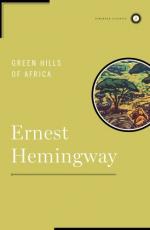|
This section contains 6,745 words (approx. 23 pages at 300 words per page) |

|
SOURCE: Whitley, Edward. “Race and Modernity in Theodore Roosevelt's and Ernest Hemingway's African Travel Writing.” In Issues in Travel Writing: Empire, Spectacle, and Displacement, edited by Kristi Siegel, pp. 13-29. New York: Peter Lang Publishing, Inc., 2002.
In the following essay, Whitley suggests that Hemingway's depiction of Africa and Africans in The Green Hills of Africa was informed by the travel writing of the adventurer Theodore Roosevelt, who promulgated the legend of the great white hunter in Africa.
Coming on the heels of Theodore Roosevelt's return from his 1909 East African hunting safari, the Pittsburgh Gazette-Times ran an editorial cartoon showing how both the people and animals of Africa had been forever changed by their encounter with the former president. Lions, snakes, birds, tigers, monkeys, and Africans in caricature all wear wire-rim glasses and big, toothy, Rooseveltian grins. “Gone, but not forgotten,” reads the caption, while a bow-tied raccoon in...
|
This section contains 6,745 words (approx. 23 pages at 300 words per page) |

|


